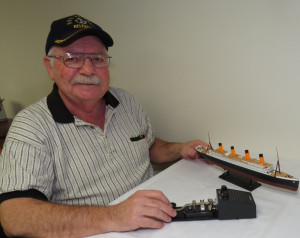By David Fleet
Editor

We are sinking fast, passengers being put into life boats. “We are putting passengers off in small boats. Cannot last much longer. Losing power. This is Titanic. CQD. Engine room flooded.
This was one of the few final messages sent by senior wireless operator Jack Phillips, an employee of the Marconi International Marine Communication Company, Ltd. during the freezing, still night of April 14, 1912 in the North Atlantic, about 400 miles off the coast of Newfoundland.
One hundred and four years ago last week, the RMS Titanic rammed an iceberg and sank, ending 1,514 lives. The 882-foot vessel was on her first transatlantic maiden voyage from Southampton, England to New York with 2,216 onboard when the disaster occurred.
The messages transmitted between nearby ships and Cape Race Newfoundland from the Titanic abruptly stopped at approximately 2:20 a.m., April 15 when the ship disappeared beneath the surface of the Atlantic.
Larry Hathcock, an Oakland County Pioneer and Historical Society member and Ortonville resident, with an understanding of Morse code and the system in place on the Titanic, will speak about the Titanic’s communication failure at the next OCPHS Small Talk presentation at 2 p.m. Sunday, April 17, at Pine Grove, the OCPHS headquarters at 405 E. Cesar Chavez Ave., Pontiac.
“My approach is to bring in the Titanic’s radio messages,” said Hathcock. “Wireless communications at the time was primitive—the ship’s Morse code was their primary means.”
Hathcock, a former US Navy Morse Code telegrapher, active August 1963 to August 1966, will use a Morse Code oscillator to reproduce the messages sent by the Titanic that fateful night. Messages that weren’t heard by the S.S. Californian, a ship that stopped in the water just miles from the Titanic, but did not have its radio equipment on when the Titanic was broadcasting its call for help.
“The Titanic was in near constant communication with Cape Race (Newfoundland’s Avalon Peninsula) on its Marconi wireless prior to hitting the iceberg as passengers passed along greetings and business messages to folks on land all over North America,” he said. “The Titanic was about 400 miles off Cape Race which was close enough to receive Morse Code to then be passed on via land lines to New York or other cities.”
Hathcock argues that the Marconi International Marine Communication Company’s focus on sending messages from wealthy passengers in order to make large profits may have interfered with safety.
“Marconi had a money-making operation,” said Hathcock. “There was pressure of doing the job and John Phillips, who ultimately perished when the ship went down, was under the control of Captain Smith, but was also paid by the Marconi Company. Consider just how many wealthy passengers were onboard—they could afford to send messages and many had businesses in the United States. And it’s not like the crew was not aware of the ice problems– reports were coming in from other ships. Should the icebergs have been more of a priority? Or was the priority making money with the messages back home?”
Hathcock and his wife have visited the Belfast, Ireland drydock that once housed the Titanic and the cemetery in Nova Scotia, Canada, where the recovered bodies of those who died in the sinking were buried. As part of the presentation he will show photos of the ship.
“The tragedy led to laws being changed,” he said. “At least some good came from the sinking of the Titanic.”
Learn more at his talk. Admission is $5 and includes light refreshments.
For more information, go to www.ocphs.org.
